Monday, May 24, 2021,
I was so excited this morning because I will start my new journey to Otsuchi Bay. This was my first time going to The International Coastal Research Centre (ICRC) -The University of Tokyo in Otsuchi Bay, Otsuchi-Cho. To get there, it takes at least 8 hours by train from Kashiwa no Ha includes local lines and the shinkansen line. This place is the furthest place from Tokyo to reach by shinkansen. Therefore, I called it the (almost) end of Honshu in terms of the shinkansen route. I used YAMABIKO 53 shinkansen to Shin-Hanamaki and continued with the local train to Kamaishi station. A car was the main transportation in Otsuchi after arriving in Kamaishi City.
大槌湾観測のため、大槌町を訪れました。大槌湾には、東京大学 大気海洋研究所国際沿岸海洋研究センターがあります。センターを訪れるのは初めてなので、朝からとても楽しみにしていました。千葉県柏の葉キャンパス駅から、新幹線を乗り継いで、岩手県釜石駅まで約8時間かかりました。釜石駅から、車で大槌町に向かいました。

Fig. 1 A dazzling view from YAMABIKO shinkansen
I was amazed by the dazzling view inside the trains, and Kamaishi City impressed me at first sight. A peaceful city surrounded by mountains and facing the Pacific ocean as a terrace. Surely this will be a healing trip! I am so excited!
新幹線からの景色はとてもまぶしく、素晴らしいものでした。大槌町は、背後は山に囲まれ、またテラスのように太平洋に面していて、とても美しい町です。楽しみ!
Tuesday, May 25, 2021,
This day was the sampling day in Otsuchi Bay. I was so nervous, but looking at Otsuchi this morning, I believe I could work. Otsuchi Bay this morning was very friendly and calm; I posted pictures of Otsuchi Bay before sampling.
大槌湾の観測の日です。とても緊張していましたが、観測を楽しみにしていました。出発の日の大槌湾はとても静かで、穏やかでした。
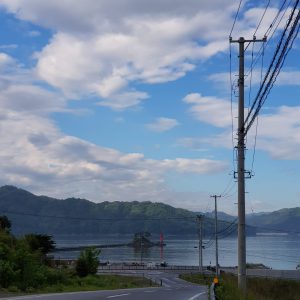
Fig. 2 Otsuchi Bay on May 25 morning
Before getting on board, we prepared our trace metals sampling equipment, including Niskin-X bottle, Light Density Polyethylene Bottles (LDPE), Acropak filter, saniment gloves; all apparatus were acid-cleaned prior to use. Didn’t forget the water to keep hydrated during sampling ^-^.
After mounted all of the apparatus on board, we were ready to sail!
乗船前に、海水をサンプリングための物品:採水器、ポリエチレン製のボトル、海水をろ過するためのフィルター、プラスチック手袋を準備しました(熱中症にならないように飲み物も忘れずに…)。全ての物品を船に積んで、準備完了です!
This time we used RV Yayoi, which I also posted in the picture below. The first station was the outermost station that directly faces the Pacific Ocean. The ship was shaking, and the wind blew pretty strong. Aside from seawater samples for trace metals and nutrients, we also took sediment and phytoplankton samples. Since I am working on trace metals, I will explain trace metals sampling in more detail. Trace metals sampling is challenging due to its naturally low concentration and easily contaminated. Therefore, we used metals-free apparatus during sampling. Upon retrieving Niskin-X bottles on deck, Niskin-X then filled with clean air that already passed through the HEPA filter to boost water flow. Akropak filter was connected to Niskin-X spigot to filter seawater samples. The filtrate was then collected into LDPE bottles for further acidification on land. After all samples were collected, the ship was moving to other stations, and the last station was located in the uppermost of Otsuchi Bay. We occupied four stations in Otsuchi Bay with variable depth from the deepest 77 m and the shallowest 8 m. Please see the pictures of the sampling processes and map of Otsuchi Bay sampling station.
観測は、観測船「弥生」を使って行いました。最初の測点は、大槌湾から太平洋に抜ける測点です。船は揺れて、風も少し強かったです。海水中の微量金属元素と栄養塩を測定するサンプルに加え、堆積物、プランクトンもサンプリングしました。私の専門は微量金属なので、クリーン採水について少し説明したいと思います。海水中の微量金属元素は、一般的に濃度が低く、汚染しやすいため、サンプリングがとても難しいです。そのためサンプリングでは、金属が使われていない物品を用います。採水器を船上に引き上げたら、採水器にクリーンエアーを流しながら海水をろ過します。ろ過した海水は、プラスチック製のボトルに分取して、陸上の実験室で酸を加えて保存します。一つの測点で観測を終えたら、湾の中にある次の測点へ向かいます。最も深い測点で水深77m、浅い測点で8m、全部で4測点の観測を終えました。

Fig. 3 Trace metals sampling apparatus
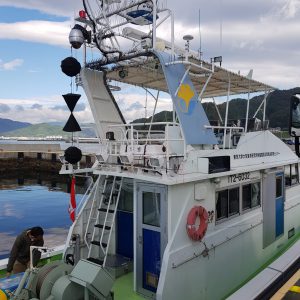
Fig. 4 R.V. Yayoi
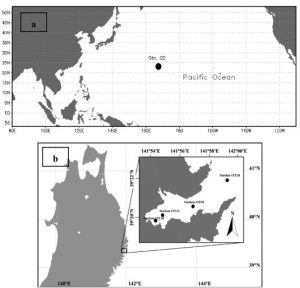
Fig. 5 Map of the sampling stations in Otsuchi Bay (Wiwit et al., Mar. Chem., 230 (2021) 103927
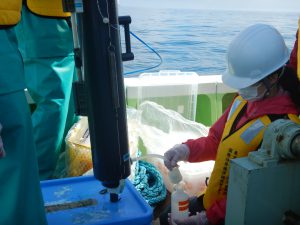
Fig. 6 Trace metals sampling processes
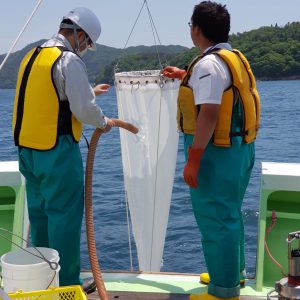
Fig. 7 Phytoplankton sampling processes
This sampling is a part of Otsuchi Bay sampling routine by ICRC-U Tokyo, which means we are conducting long-term observation in Otsuchi Bay.
大槌湾では、毎年同様の観測を長期に渡って行っています。
Idha Y. Ikhsani

